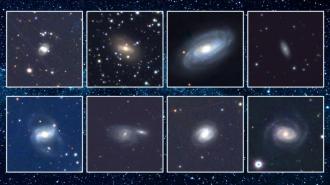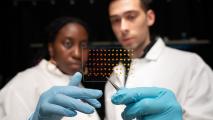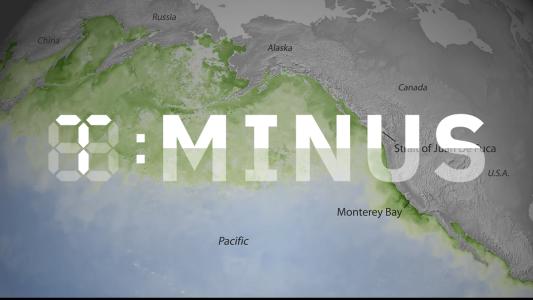Star-shredding black holes are everywhere in the sky if you just know how to look for them. That’s one message from a new study by MIT scientists, appearing in the Astrophysical Journal.
The study’s authors are reporting the discovery of 18 new tidal disruption events (TDEs) — extreme instances when a nearby star is tidally drawn into a black hole and ripped to shreds. As the black hole feasts, it gives off an enormous burst of energy across the electromagnetic spectrum.
Astronomers have detected previous tidal disruption events by looking for characteristic bursts in the optical and X-ray bands. To date, these searches have revealed about a dozen star-shredding events in the nearby universe. The MIT team’s new TDEs more than double the catalog of known TDEs in the universe.
The researchers spotted these previously “hidden” events by looking in an unconventional band: infrared. In addition to giving off optical and X-ray bursts, TDEs can generate infrared radiation, particularly in “dusty” galaxies, where a central black hole is enshrouded with galactic debris. The dust in these galaxies normally absorbs and obscures optical and X-ray light, and any sign of TDEs in these bands. In the process, the dust also heats up, producing infrared radiation that is detectable. The team found that infrared emissions, therefore, can serve as a sign of tidal disruption events.
By looking in the infrared band, the MIT team picked out many more TDEs, in galaxies where such events were previously hidden. The 18 new events occurred in different types of galaxies, scattered across the sky.
“The majority of these sources don’t show up in optical bands,” says lead author Megan Masterson, a graduate student in MIT’s Kavli Institute for Astrophysics and Space Research. “If you want to understand TDEs as a whole and use them to probe supermassive black hole demographics, you need to look in the infrared band.”
Other MIT authors include Kishalay De, Christos Panagiotou, Anna-Christina Eilers, Danielle Frostig, and Robert Simcoe, and MIT assistant professor of physics Erin Kara, along with collaborators from multiple institutions including the Max Planck Institute for Extraterrestrial Physics in Germany.
Heat spike
The team recently detected the closest TDE yet, by searching through infrared observations. The discovery opened a new, infrared-based route by which astronomers can search for actively feeding black holes.
That first detection spurred the group to comb for more TDEs. For their new study, the researchers searched through archival observations taken by NEOWISE — the renewed version of NASA’s Wide-field Infrared Survey Explorer. This satellite telescope launched in 2009 and after a brief hiatus has continued to scan the entire sky for infrared “transients,” or brief bursts.
The team looked through the mission’s archived observations using an algorithm developed by co-author Kishalay De. This algorithm picks out patterns in infrared emissions that are likely signs of a transient burst of infrared radiation. The team then cross-referenced the flagged transients with a catalog of all known nearby galaxies within 200 megaparsecs, or 600 million light years. They found that infrared transients could be traced to about 1,000 galaxies.
They then zoomed in on the signal of each galaxy’s infrared burst to determine whether the signal arose from a source other than a TDE, such as an active galactic nucleus or a supernova. After ruling out these possibilities, the team then analyzed the remaining signals, looking for an infrared pattern that is characteristic of a TDE — namely, a sharp spike followed by a gradual dip, reflecting a process by which a black hole, in ripping apart a star, suddenly heats up the surrounding dust to about 1,000 kelvins before gradually cooling down.
This analysis revealed 18 “clean” signals of tidal disruption events. The researchers took a survey of the galaxies in which each TDE was found, and saw that they occurred in a range of systems, including dusty galaxies, across the entire sky.
“If you looked up in the sky and saw a bunch of galaxies, the TDEs would occur representatively in all of them,” Masteron says. “It’s not that they’re only occurring in one type of galaxy, as people thought based only on optical and X-ray searches.”
“It is now possible to peer through the dust and complete the census of nearby TDEs,” says Edo Berger, professor of astronomy at Harvard University, who was not involved with the study. “A particularly exciting aspect of this work is the potential of follow-up studies with large infrared surveys, and I’m excited to see what discoveries they will yield.”
A dusty solution
The team’s discoveries help to resolve some major questions in the study of tidal disruption events. For instance, prior to this work, astronomers had mostly seen TDEs in one type of galaxy — a “post-starburst” system that had previously been a star-forming factory, but has since settled. This galaxy type is rare, and astronomers were puzzled as to why TDEs seemed to be popping up only in these rarer systems. It so happens that these systems are also relatively devoid of dust, making a TDE’s optical or X-ray emissions naturally easier to detect.
Now, by looking in the infrared band, astronomers are able to see TDEs in many more galaxies. The team’s new results show that black holes can devour stars in a range of galaxies, not only post-starburst systems.
The findings also resolve a “missing energy” problem. Physicists have theoreticially predicted that TDEs should radiate more energy than what has been actually observed. But the MIT team now say that dust may explain the discrepancy. They found that if a TDE occurs in a dusty galaxy, the dust itself could absorb not only optical and X-ray emissions but also extreme ultraviolet radiation, in an amount equivalent to the presumed “missing energy.”
The 18 new detections also are helping astronomers estimate the rate at which TDEs occur in a given galaxy. When they figure the new TDEs in with previous detections, they estimate a galaxy experiences a tidal disruption event once every 50,000 years. This rate comes closer to physicists’ theoretical predictions. With more infrared observations, the team hopes to resolve the rate of TDEs, and the properties of the black holes that power them.
“People were coming up with very exotic solutions to these puzzles, and now we’ve come to the point where we can resolve all of them,” Kara says. “This gives us confidence that we don’t need all this exotic physics to explain what we’re seeing. And we have a better handle on the mechanics behind how a star gets ripped apart and gobbled up by a black hole. We’re understanding these systems better.”
This research was supported, in part, by NASA.
Republished with permission of MIT News. Read the original article.





